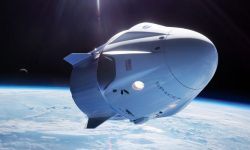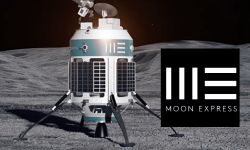
Last week, the 70th International Astronautical Congress (IAC) was held in Washington D.C. The lunar plans of NASA took a prominent place. The US space agency wants to bring humans back to the Moon by 2024 and relies heavily on the private sector to do that. In particular, it requires a crewed lunar lander and a space vehicle capable of transporting astronauts between the lunar orbit and the surface of the Moon. This is a contract that Blue Origin, the space company of Jeff Bezos, would like to win.
Blue Origin joins forces with three historic space industry giants
Blue Origin has announced its alliance with three heavyweights in the US space industry : Lockheed-Martin, Northrop Grumman and Draper. Northrop Grumman designed the Apollo lunar lander, Lockheed-Martin has extensive experience in the life support system and it was Draper’s guidance systems that allowed Neil Armstrong and Buzz Aldrin to touch the lunar surface. In other words, Blue Origin has assembled a real dream team. We can also imagine that such a group of interests has a very important political weight.
Well-distributed roles between Blue Origin and its partners
In short, Blue Origin would design the descent vehicle. It would draw directly on the architecture of the Blue Moon lander which is already in development for several years. Lockheed-Martin would take care of the lift vehicle, the pressurized part of the vehicle to bring the astronauts back into lunar orbit. Northrop Grumman would work on a transfer vehicle between the lunar orbit of the LOP-G and the low lunar orbit. Draper would obviously take care of the navigation systems of these different vehicles.
Blue Origin’s proposal has everything to please NASA
Among all the proposals to be received by NASA, this proposal seems particularly attractive because it is based on a vehicle whose development has already begun. The BE-7 engine that must allow landing on the Moon has already been tested several times. This is an important asset given the tight schedule of the Artemis program. It also involves many traditional players in the US space industry, which will streamline the work methods and facilitate the vote of members of the US Congress.

Blue Origin wants to participate in the conquest of the Moon
– News of June 5, 2018 –
During a conference on May 25, Blue Origin boss Jeff Bezos detailed how his company could participate in NASA’s lunar adventure. The richest man in the world is convinced that he must permanently settle on the Moon before trying to go to Mars. The new direction taken by NASA under the Trump administration suits him perfectly. This collaboration could first take the form of a vehicle, for example a lunar lander that could cling to the LOP-G.
In fact, Blue Origin is already developing such a vehicle, called Blue Moon, an unmanned spacecraft capable of delivering four and a half tons of material to the surface of the Moon. Blue Moon would also be able to bring back some lunar matter to Earth. The spacecraft uses the vertical takeoff and landing technologies developed for the New Shepard rocket, and could be launched from a New Glenn rocket.
Last year, Blue Origin detailed how this vehicle could be used to help build a lunar colony, with flights that could start as early as 2020. Blue Origin wants to carry out these missions in collaboration with NASA or in a wider partnership. Jeff Bezos does not hide his enthusiasm for the European initiative Moon Village which would bring together different nations and companies around the same colony. If Blue Origin can not find good partnerships, the company is ready to go it alone, until its boss is ruined if necessary.
Jeff Bezos also recalled his desire to inject each year a little of his personal fortune in his space adventure. For the moment, Blue Origin can look forward to the future with $ 1 billion in cash injected into the company each year. If partnerships for a lunar adventure materialize, the American billionaire will not hesitate to accelerate the pace of spending.
The lunar adventure begins with the development of reliable and efficient launchers. Jeff Bezos said that Blue Origin has purchased the barge that will be used for the landings of the New Glenn rocket at sea. Ship adaptation work should start quickly.
– News from May 1, 2018 –
Many see Blue Origin as a future giant in the space industry. Having as a founder the richest man in the world, Jeff Bezos, provides a financing capacity that few other companies can afford. To put things in perspective, Jeff Bezos would currently able to fund the Apollo program on its own. Yet, although Blue Origin was founded before SpaceX, the results are long overdue. Eighteen years later its creation, Blue Origin still has no operational space vehicle.
– News of April 11, 2017 –
Jeff Bezos, who has recently become the second richest man in the world, has announced that he will sell $ 1 billion a year to fund Blue Origin, his reusable rocket development company. He is convinced that the space industry is currently in a state comparable to the internet in the early 1990s.
The company aims to take tourists into space in 2018. It also has in its cards the development of the New Glenn, a rocket absolutely monstrous and nonetheless recoverable.
As Jeff Bezos said, if the cost of airliners had remained the same as in 1940, then the aviation industry today would be tiny.
Blue Origin, child of the Launch Act
From the very beginning and for a very long time, governments have had exclusivity for space activities. Remained under the control of states or even armies for years, space remained a domain reserved for science, espionage or political propaganda. But for the United States, champions of economic liberalism, staying in this situation was not an option. In 1984, the Launch Act allowed private companies in the country to manufacture their own launchers and have their own launch site. This law is probably the cornerstone of the movement known today as the New Space.
The Launch Act has been slow to take effect. The 1980s and 1990s were marked by a few start-ups : the end of the USSR and the massive privatization of Soviet space technologies gave birth to companies such as Sea Launch or International Launch Services. But it was the beginning of the 2000s that marked a real break with the arrival of the Silicon Valley in the sector. The year 2000 especially, because that year was founded the company Blue Origin by Jeff Bezos, the boss of Amazon, who made a fortune with the beginnings of the internet. He decided to take advantage of this financial windfall to try to fulfill his teenage dreams : in an interview given in 1982, when he was only 18, he said he wanted to create colonies in orbit able to welcome two to three million inhabitants.
Blue Origin grows with the Delta Clipper team experience
Twenty years and a few million dollars later, Jeff Bezos decided at the age of 36 to establish a real space company. Although this may be reminiscent of Elon Musk’s journey with the creation of SpaceX, both companies have had very different practices since the beginning. While SpaceX, founded two years after Blue Origin, communicates excessively, on the other side Blue Origin feeds the secret. Thus, it is only in 2003 that the existence of Blue Origin was made public. In 2005, Jeff Bezos reveals in a small Texas local newspaper his plans for his new venture : to build a rocket able to take off and to land vertically, and which will take men to the border of space. Its inspiration is the McDonnell Douglas Delta Clipper Demonstrator. Built in the early 1990s on the orders of the US Department of Defense, it is a prototype of reusable launchers, where the rocket is able to achieve its goal by using only one floor. The constraints for this type of vehicle are enormous, especially if it must be reusable. The McDonnell Douglas demonstrator flew up to 2500 meters above sea level. But this small vehicle laid the foundation for reusable rockets.
Blue origin recruited some engineers who worked on the Delta Clipper and gets to work. In 2005, the company launched its first rocket called Charon. At the time, Charon is more an aeronautical project than an aerospacial project : Charon is indeed equipped with jet engines similar to those which can be found on the planes. But this allows Blue Origin to test vertical take-offs and landings. Since 2006, a new demonstrator called Goddard begins the test flights. This time, 9 rocket engines are used. The Goddard manages to rise to a height of 100 meters before returning and landing. Whether in the general form or in the technical demonstration, it is obvious that the Delta Clipper has inspired Blue Origin.
New Shepard, the launcher that changes everything
It was also at this time that the name of New Shepard began to appear. It is this vehicle that must realize the vision of Jeff Bezos : take men to the border of space in a fully reusable rocket. In his rare interviews, the boss of Blue Origin suggests that his company would like to turn to orbital flying in the long run.
The development of New Shepard will require a significant technological advance from Blue Origin. After a few years of work, in 2011 a first prototype of the rocket named PM2 is installed on a launch pad. PM2 has a singular, very squat appearance. It is powered by five engines developed internally by the company. It is also equipped with four small fins at its base. On its first flight, the PM2 manages to climb up to 167 meters altitude and returns to land gently. Only three of the five engines are used in this demonstration. Four months later, the next test is much more ambitious : this time the PM2 uses all of its engines and manages to climb to an altitude of 14 km and a speed of Mach 1.2 before to be destroyed by its security systems.
At this time, Blue Origin is still so secret. It suggests plans for a partially reusable orbital rocket. We can recognize the general shape of PM2 booster surmounted by a second floor. In the early 2010s, SpaceX has just made the first shot of its Falcon 9 rocket. Elon Musk’s company also relies on reuse and does not rely on suborbital flights either. Blue Origin had to make the most of the PM2 demonstrator to build New Shepard. This task lasted until 2015. It is also during these years that the company was able to secure huge funding : the value of Amazon is multiplied by more than 1000 since its IPO. Jeff Bezos becomes one of the richest people in the world. The billionaire finances his space adventure : in 2014, he has already invested more than half a billion dollars in Blue Origin.
New Shepard is conceived as a vehicle in two parts : a booster that deals with the propulsion and a capsule that must be able to accommodate passengers. The capsule was tested in 2012 but it took two and a half more for the booster to show on a launch pad. On April 29, 2015, New Shepard rises to an altitude of 93 km, just a few kilometers from the official space boundary. The capsule of the spacecraft comes to rest under his parachute, but to the booster its is more complicated : it crashes. But Blue Origin continues testing the New Shepard. Between April 2015 and the beginning of 2018, the rocket and its capsule flew eight times. All flights following the first were full successes.
The design is a little different compared to PM2 demonstrators : the overall shape rather squat is preserved but the propulsion is provided only by a single engine BE-3. Blue Origin only performs suborbital flights, but the company manages to push the concept of reuse far enough : no SpaceX rocket flew more than twice. New Shepard 2 has made five flights.
New Glenn and New Armstrong, future Blue Origin star projects
Blue Origin is well positioned to send humans into space in its capsule over the next few months. It has been known since 2012 that Jeff Bezos’ company worked on an orbital rocket. The first details emerge in 2015 and 2016. New Glenn is a heavy launcher that must be reusable a large number of times, planned in two versions with two or three floors. The rocket must be capable of placing 45 tons in low orbit or 13 tons in geostationary transfer orbit. Like many rockets currently under development, it uses the methane liquid oxygen pair to propel its first floor. This should allow the first floor to be recovered up to 100 times. The first stage is propelled by seven V4 engines, monsters of a power exceeding the power of the engines of the Space Shuttle. On the second and third floors, there are BE-3s that have already proven themselves with the New Shepard.
If Blue Origin respects its schedule, New Glenn should fly in 2020. Blue Origin has other ideas under study but the company is still as secret on its future projects. We only know one name : New Armstrong. To learn more, we must listen to the different statements of Jeff Bezos. He said, for example, that New Glenn will be the lightest orbital rocket in the business. In other words, the New Armstrong will probably be a monster. To follow the progress of Blue Origin, it is necessary to deal with the scattered communication of Blue Origin. Jeff Bezos is known for being more long-term oriented : Amazon lost money for many years before becoming the current giant. His boss invests every year in Blue Origin and does not seem particularly eager to make a quick profit. It may be one of Blue Origin’s greatest strengths : Jeff Bezos’ patience and financial resources allow him to plan for the very long term without having to worry about ever-changing shareholders or governments.
For the moment, Blue Origin has not made any orbital flights. But it can be expected that the company will become the Amazon of space over the next five to ten years, remaining in the shadows for years before conquering the first place in a few quarters.









